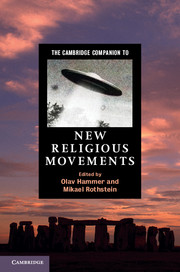Book contents
- Frontmatter
- Introduction to new religious movements
- Part I Social science perspectives
- Part II Themes
- 4 History and the end of time in new religions
- 5 Charismatic leaders in new religions
- 6 Rituals in new religions
- 7 Canonical and extracanonical texts in new religions
- Part III New religious movements
- Index
- Other titles in the series
6 - Rituals in new religions
from Part II - Themes
Published online by Cambridge University Press: 28 September 2012
- Frontmatter
- Introduction to new religious movements
- Part I Social science perspectives
- Part II Themes
- 4 History and the end of time in new religions
- 5 Charismatic leaders in new religions
- 6 Rituals in new religions
- 7 Canonical and extracanonical texts in new religions
- Part III New religious movements
- Index
- Other titles in the series
Summary
New religions can appear novel because they involve unfamiliar rituals. However, these same rituals can be presented as proof of a group's authentic participation in time-honored traditions. Novelty and antiquity can be either attractive or threatening, legitimizing or repellant. This tension between new and old – expressed in polarizations between tradition and innovation, or authenticity and adaptation – is at the heart of both religious and scholarly interest in ritual. Doing a ritual “the way it has always been done,” but performing it with appropriate attention or enthusiasm (remembering that “appropriate” might mean either “almost casually” or “with restraint”), is often intimately related to the depth or shallowness of a person's involvement in a religion or group. Scholarly theorization of the category of “ritual” is rife with debate about the definitive centrality or marginality of repetition, redundancy, structure, formality, archaism, understanding, and their possible opposites. There can also be contention among religious people about the expected outcomes of ritual practices: while some insist that only “spiritual” results are appropriate others gladly anticipate “material” rewards.
This chapter discusses ritual in relation to four new religions: Paganism, ISKCON, the Soka Gakkai, and Santo Daime. It does not insist on a particular definition of ritual, nor does it present a new theory of ritual. Rather, it assumes that a range of religious actions (including verbal and literary communication) are usefully considered to be examples of this polyvalent but contested category. It recognizes that rituals are not all alike functionally, structurally, formally, socially, epistemologically, or experientially. Indeed, some people vehemently object to the identification of particular acts or events as rituals.
- Type
- Chapter
- Information
- The Cambridge Companion to New Religious Movements , pp. 97 - 112Publisher: Cambridge University PressPrint publication year: 2012

